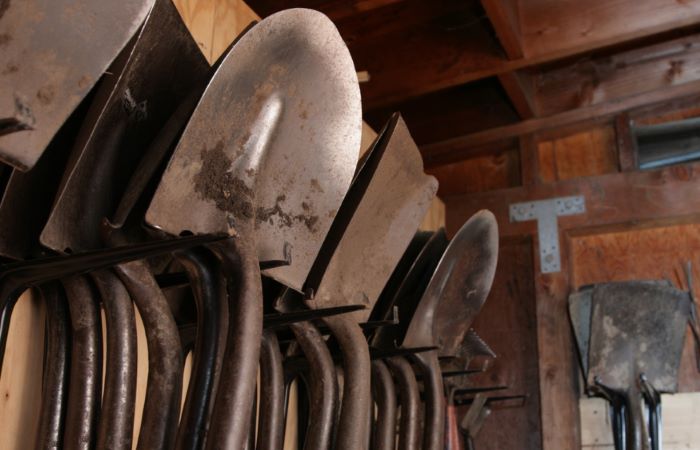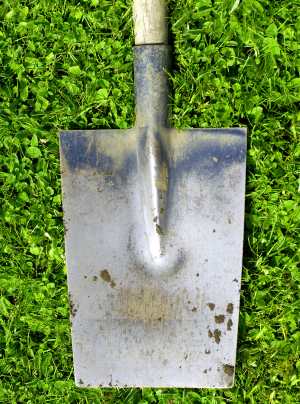Are a spade and shovel the same? No, they aren’t, and any avid gardener will be quick to point out the difference.
While both can dig a hole, one tool is much better for the task.

Shovels and spades come in many designs that have a specific function in the garden, so choosing the right one can get confusing.
So what is the difference between a spade and a shovel?
In a hurry? See our guide on the best garden shovels to get a head-start on your next dig.
I have the answer in this guide, where I explain the differences between spades and shovels and what gardening projects they tackle best.
I also talk about the various types and features of spades and shovels so you can stock your shed with the best gardening tool for every need.
Gardening Spades

A spade is handy in the garden for digging straight edges or breaking up clumps of dirt. Spades are ideal for creating the perfect size hole for plants as they cut down into the soil with little effort.
Types Of Spades
Garden Spade
A garden spade is an all-purpose tool with a medium-size rounded blade with a pointed tip. This spade is perfect to loosen soil in garden beds and to transplant shrubs and plants.
The blade is concave and has footsteps on either side of the handle for applying extra downward pressure while digging.
Drain Spade
A drain spade has a narrow, slightly concave blade with a rounded tip. This tool is also known as a transplanting spade.
This type of spade is ideal for making precise holes. A drain spade can also dig long, narrow trenches for drain lines, sprinkler systems, or vegetable rows.
Scraper/Edger Spade
In the garden, scraper spades have a sturdy, flat edge that does wonders for edging lawns and planter beds or cleaning weeds out of sidewalk cracks.
This scraper is also the go-to tool for removing ice from driveways and old roof shingles.
Weed/Root Spade
A weed or root spade has a blade with a “V” shape with a sharp, flat-nose tip and serrated edges.
This design cuts through tough soil and rips weeds and roots apart.
Spade Features
Shape
The way to discern a spade from a shovel is the shape where the blade and handle meet. From the side, a spade continues in a straight line from the handle through the blade.
Not having this bend creates a flat surface which keeps the edge of holes clean and straight.
Blade Choices
Spades come with steel blades with options like:
- Rounded/Pointed
- Narrow/Wide
- Serrated
- Flat
- Footpads
Which blade you choose depends on if you need to dig, cut, chop, slice, weed, scrape, or trench during the gardening season. A wide footpad allows you to safely and comfortably use your foot to exert pressure on the blade.
Handle Shapes
Most spades have a short handle (48-inches or less) and a grip in the shape of a sideways “D” (D-handle). The grip typically has foam or rubber over it for comfort.
Task-specific spades may have a long, straight handle. Many edging spades come with a “T” handle.
Material
Spade blades are stainless steel. Handles are carbon, fiberglass, wood, plastic, or metal. Grips of D-handles can be metal or plastic. For better grasp and comfort, many spades have padding on the handle grip.
What is a spade used for?
While you can dig with a spade, I find the shape is more conducive for slicing straight down into the soil for clean-edged holes or trenches.
The straight line of the handle and blade work well for lifting sod, scraping weeds down, or edging grass or planter beds.
A spade is excellent for turning garden soil. The blade of a spade makes quick work of breaking up lumps of dirt or “chopping in” fertilizer into the ground.
Gardening Shovels

Shovels are a gardening must-have. You can dig, chop, scoop, and pry easily with a quality shovel. The design of a shovel makes slicing straight lines difficult, but it makes most other gardening tasks a breeze.
Types Of Shovels
Digging shovel
Digging shovels are the most common shovel in a homeowner’s shed. This shovel is perfect for digging up or dividing plants, moving soil, and cutting through roots and tough soil.
These shovels have a curved-scoop blade with a rounded, pointy tip and a footpad. The handles of a digging shovel can be long or short.
Scooping shovel
When you need to relocate large amounts of dirt, compost, or gravel fast, a scoop shovel is the answer.
These shovels have a wide, flat blade, with a straight tip. The blade has sides to keep the material from falling off during use.
Trenching shovel
Trenching shovels can be a gardeners friend when you need to clear long trenches for laying out vegetables or to install soaker hoses.
These types of shovels have a long handle. The blades feature squared-off sides, slightly pointed tip, and an elongated, slim shape that clears away dirt quickly.
Trowel shovel
When you need a small hand tool in the garden for repotting, weeding, and planting a trowel is the only shovel for the job.
The grip of the handle directly attaches to the pointed blade giving you all the control you need to handle minor garden tasks in tight spaces.
Multi-purpose shovel
A multi-purpose shovel incorporates all the blade features you may need while gardening.
This multi-duty tool has a blade wide enough to dig and move soil. It also has teeth on the outer edges of the blade to cut through roots, grass, or impacted earth.
Shovel features
Shape
A shovel has an angle or bend where the handle connects to the blade. This design makes it easier to scoop and lift loose material. The shape also provides more force when prying up tough dirt or digging out rocks.
Blade Choices
Like spades, you can find many blade options like:
- Round and pointed/Square and flat
- Flat/Concave base
- Angular
- Serrated
- Footpads
Each blade option can make performing different garden jobs easier than others.
Handle
Shovel handles can be long or short. I find long-handled shovels easier on the back when turning over garden soil or gathering up compost. Short-handled shovels are nice in tight areas.
Material
Shovel blades are steel. Handles can be wood, fiberglass, or metal. D-handle grips can be metal or plastic. Many long-handle shovels offer a foam or rubber grip at the end, just like shorter D-handle types.
What is a shovel used for?
A shovel has a design made to move loose material from one area to another efficiently.
I find a garden shovel indispensable when digging holes for new shrubs, turning the soil, lifting out plants, scraping up mulch, and prying up stones.
A shovel can fill a wheelbarrow with dirt or compost quickly.
In Summary
In my garden, I use both my spade and shovel regularly. While a shovel handles just about any garden task, a spade delivers cleaner results, which makes my landscaping look fantastic.
Should you go with a long handle or short? Get a blade that’s pointy or straight? Should the handle be wood or fiberglass? The choices can become overwhelming.
I hope using this guide helps you find the perfect spade or shovel for your needs.
When it comes down to spade versus shovel, there doesn’t need to be one winner. Take the time to explore all the different options above, so you can make garden and landscaping work more enjoyable!










